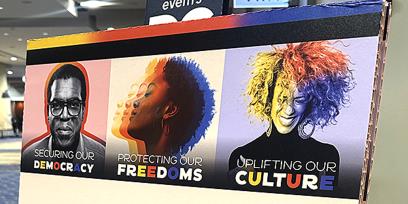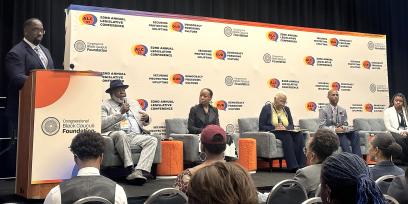The Congressional Black Caucus Foundation Annual Legislative Conference, the largest Black public policy conference in the nation, was abuzz with big names, big ideas and big aspirations Sept. 20-24 in Washington, D.C., and AFT members were right in the midst of it, attending two days of professional development that focused on the state of public education for Black students and Black educators.
Co-sponsored by the AFT; the National Education Association; and the White House Initiative on Advancing Educational Equity, Excellence and Economic Opportunity for Black Americans, sessions titled, “The Courage to Teach” featured educators, union leaders, activists and elected officials who conveyed the urgency of this moment—as white supremacist ideology undermines public education, and its proponents attack Black people—and offered real-world solutions. This is the ninth year the AFT has organized sessions at the conference.
AFT Secretary-Treasurer Fedrick Ingram fired up the crowd at the panel discussion on the first day by evoking the pride Black families express at high school graduation ceremonies, with elders wielding bullhorns to cheer for their embarrassed graduates. “That’s the hope,” he said, an irrepressible and undeniable emotion that propels the next generation to do better than the last. “You’ve got to be able to channel that hope.”
What’s at stake
“We need a revolution in public education,” said Rep. Jamaal Bowman (D-N.Y.), outlining the problems plaguing public schools: lack of early childhood education and child care, a disproportionate number of Black and brown children placed in special education programs, book bans, too much standardized testing, unaffordable higher education and more. “These are the data points we must put front and center,” he said.
Throughout history, those who wanted to maintain control over others have “understood that an uneducated citizenry was what they needed so that they could continue their unfettered march toward power,” said NEA President Becky Pringle, citing the specific attack on Black students who are now not allowed to learn their own history in school. “It’s no mistake. It is a concerted effort,” she said, vowing that the NEA and the AFT will stand up “every day, all day” to defend teaching honest and inclusive history. “Together, we will transform the public education system into something it was never designed to be: a racially and socially just and equitable system that prepares every student to succeed in this diverse and interdependent world.”
Jitu Brown, national director of the Journey for Justice Alliance, agreed that Black people are under attack, pushed out and marginalized. “Black people have been purged using housing and education as the weaponry,” he said. “They are using basic quality-of-life institutions to squeeze us out.” At the same time, Brown echoed Ingram’s notion of Black excellence, that “we shine despite efforts to make us dim.”
Nicole Austin-Hillery, president and CEO of the CBCF, noted the broader scope of the problem: “Democracy is under attack. That means everything that is the foundation of democracy—and education we know is at the foundation of our democracy.”
Resistance is key, said Ladara Royal, a social studies teacher from Orange County, Fla.: Despite the current education environment, he will continue to embrace his identity as an unapologetic Black educator. If Florida wants educators to teach that slavery was beneficial to Black people—as a sort job training—he can teach that that concept is the truth according to Florida public education, but introduce historians who argue differently. “We have to realize what power we have as educators,” he said. “There is still strength in numbers. There is still strength in unions. Don’t be afraid to use it.”
Lynne G. Long, the chair of the department of teaching, learning and professional development at Bowie State University, described “perseverance” as resistance, describing how Bowie State, a Black teachers’ college started in a Baltimore church in 1865, now boasts 29 undergraduate majors, 20 master’s degree programs and two doctoral programs on a 300-acre campus. When recruitment for the teaching program got tough, Long and others recruited from community colleges, high schools and middle schools applied for grants—and won $9.8 million for the department. This year, 80 students are on track to be certified, she said.
Once those teachers are in place, they need continued support, said Alana Rigby, a first-year teacher from Montgomery County, Md., and past president of the Student Florida Education Association. They need community, and the best place to find it is the union, she said. She also urged teachers to do the extra work to help Black students succeed, finding ways to add Black history into curricula that are missing it. “Our curriculum is not designed for our Black students to succeed,” she said, but teachers can still highlight the “Black joy” hidden within their lessons.
For support with all of this, Alexis Holmes, executive director of the White House Initiative on Advancing Educational Equity, Excellence, and Economic Opportunity for Black Americans, says her office is available. “We’re Black, and we’re unapologetic about it,” she told conference participants. “Within all the noise, within the fights we have, there is a place within this administration for us to have conversations and gain information on those issues that are impacting us and … encompassed by education, equity and economic opportunity.”
Resources and funding
Holmes was also on deck during two professional development sessions held at the Department of Education, where department leaders shared existing programming—including grant availability—that supports Black education. A session on student debt relief shared details about various relief programs available to educators and their families. Another described the administration’s Raise the Bar: Lead the World call to action for education equity and excellence, including its support for career education and funding made available to advance it.
A session on literacy described government-financed programs such as public television shows and even small projects like posters in laundromats encouraging parents to name and spell colors as they fold laundry with their children—and noted funds are available to educators and other community members who meet criteria. More information is available on the department’s website.
A session on how to file complaints regarding discrimination or hostile environments generated the most interest, as it described newly released guidance for educators facing the notorious challenges of teaching about Black history and culture. With details about what does and does not rise to a violation of federal law, participants were able to discuss whether, for example, a class in Mexican history could be required for high school graduation (yes) or if an instructor could teach Holocaust denial (no). With its language against creating a “hostile environment,” the statute inspired much consideration regarding book bans and prohibitions on classroom content.
Solutions already available and underway
On the second day of the Courage to Teach sessions, another panel of seasoned experts acknowledged the struggle but offered solutions that are already working.
“The Woke Act is the Black Attack Act,” said Ingram, an “all-out assault on Black people,” referring to Florida legislation that bans teaching Black history and culture and cancels Advanced Placement Black history courses. He named the NAACP travel advisory warning Black people that Florida is a hostile state, and referenced bans on teaching diversity, equity and inclusion. Along with poor pay and lack of respect, these working conditions are pushing teachers out of the profession, he said: There are 9,000 teacher vacancies in Florida.
What to do? Panelists agreed the key is to get involved. “Some of us have got to get in the policy-making sphere,” said Leon Russell, chair of the NAACP national board of directors. “If we don’t, public education will be destroyed.”
Educators must know their state legislators, said Laura Hall, president of the National Black Caucus of State Legislators and a state representative from Alabama, and teachers must be part of policy conversations. “We have to have that kind of relationship within our community as we work to create a better environment for our children.”
“You have to become engaged,” said Newark, N.J., Mayor Ras Baraka, whose own fight for public schools in Newark is legendary—and involves persistence in the face of former Gov. Chris Christie, who opposed his advocacy. Ronsha Dickerson, a national organizer for the Journey for Justice Alliance, described grassroots community members attending school board meetings, insisting they have the right to vote for their school board members—rather than have them appointed—and waging successful campaigns that involved the local union and other community organizations.
That community connection is essential, said Baraka. “You can’t divorce schools from the communities that they’re in. The school cannot exist in excellence if the neighborhood is in bad shape.”
“The solutions we need, they already exist,” said Glenn Harris, president of Race Forward. “They’re in our communities.” Teachers, parents and unions are already working together on things like community schools. Civic organizations can pitch in with classes in Black history and by meeting other community needs, suggested Hall. “We have the shining lights of community schools all over this country,” said Ingram. It’s just a matter of scaling up that model. More generally, it’s about getting back to our union roots and our civic roots, he said, attending school board meetings and getting involved at a policy level.
Perhaps CBCF’s Nicole Austin-Hillery said it best at the first session when she challenged participants to walk away from the conference inspired to act. “This is about us getting the work done and not just making nice speeches, but going back to the communities with a game plan about how we are going to create change and have impact.”
[Virginia Myers]



